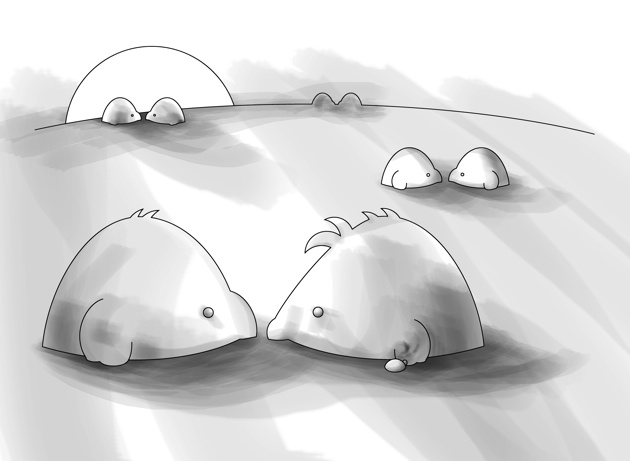What is Facilitation?
Facilitation: to make easier or less difficult; help forward (an action, process, etc.)
This definition paints the picture of what it means to facilitate a session really well. As a facilitator, your job is to help a person, or a group of people, traverse a problem space. The context of the problem space could be one where you, as the designer, need to learn more about what is going on so you can properly craft an effective solution. Or it could be a situation were the participants needs to identify and solve the problem on their own, while you take that solution back and refine it further.
Every session has a facilitator, and most of the time that person is identified upfront. Occasionally, however, the role of the facilitator manifests itself more organically. The participant that takes up this mantle is one that starts directing people using a series of questions, comments, or stories. Doing this encourages the other participants to contribute their own ideas, suggestions, or questions that end up driving the rest of the session.
The role of a facilitator is one of many roles within a session. Typically, you will have general participants (people who are actively engaged in the session), a note taker (the person responsible for noting any key decisions or takeaways from the session), and the leader (the person driving the conversation and hitting all the key topic areas). The leader and the facilitator can be the same person, but that is not always the case. If there is a defined leader for a session, the facilitator is there to support their direction and to ensure that the conversation remains productive and engaging for all the other participants.
What Makes a Good Facilitator?
Good facilitators are not made overnight, it takes practice and learning from past mistakes so that future sessions progressively get better. Still, anyone can eventually become a good facilitator, and becoming a good facilitator starts with emphasizing certain key personal qualities.
Qualities of a Good Facilitator
The qualities that make up a skilled facilitator are ones that every human has, they just need to be sharpened and brought to the surface.
- Good Listener: Facilitating is more about listening to the conversation that is going on around you than actively participating in it. This means as a facilitator, it is important to keep your thoughts, ideas, and comments to yourself and let the participants generate the content on their own.
- Empathetic: Over the course of many facilitated sessions, you will interact with a diverse range of people and personalities. Some of these people and personalities need your support more than others as the facilitator of the session.
- Director of People: There is a difference between directing and leading a group of participants. Leading is taking the reigns and potentially pushing participants in a single direction. Directing encourages the participants to move in a direction that makes sense to them.
- Enthusiastic: Creating and maintaining the energy of a session is no small task. This is especially true for sessions that span hours, or even days. The facilitator needs to be the source of this momentum, from start to finish.
- Diplomatic: Each participant is passionate about the topic that is being discussed, that is why he or she is in the session in the first place. Sometimes this passion can take a productive conversation and turn it into an argument. Facilitators need to manage these situations appropriately and maintain a safe and positive environment for all participants.
- Patient: Getting to the heart of an issue, or problem space, takes time. A proficient facilitator does not try to rush participants to a solution or resolution too fast.
Be a better facilitator
Once you have got the basics to facilitation down, there is only really one way to improve your facilitation skills … practice. The first few sessions may not go as smoothly, and that is ok as long as the participants get what they need, or you get what you need out of them. Identify the areas of weakness that you experienced over the course of a session and determine what you need to do to avoid the same mistakes in the future. If a session is recorded, going back and watching or listening to yourself facilitating will do wonders for improvement.
Facilitation is not easy, it takes time and practice to hone your skills, style, and mindset. Eventually you will stop yearning to take part in the conversation that is occurring around you and simply sit back and interject your guidance and direction when it is most needed.
Common Types of Facilitation
Facilitation typically happens in three contexts: one–on–one facilitation, group facilitation, and public speaking. Each of these contexts has you, the facilitator, managing a conversation.
One-On-One
These are situations where you are meeting with a single person to discuss or work through a specific topic area. These typically take the form of an interview, where you are using a guide to touch on a variety of topic areas and asking exploratory follow up questions. These sessions hardly ever occur independently, however, and are rather a series of many interviews over the course of a specific time span.
Group Based
Gathering a group of participants together in a conference room to work through a specific topic collaboratively is a great way to uncover new and previously undiscovered ideas. These groups need someone to help direct them through one or more activities and reach this shared understanding to help generate creative and unexpected solutions.
Public Speaking
Getting behind a podium or on a stage is a form of facilitation, it can be considered a one-to-many facilitated session. As the speaker, you are directing a crowd of people through a specific topic area and imparting your own perspective and knowledge about that topic. This type of session shares many of the same qualities of the one-on-one facilitation and group-based facilitation. They all take a certain amount of planning, preparation, and practice to pull off successfully, and the method of doing that is common across all three.
Being a Good Facilitator is Key to Being a Good Designer
Designers facilitate all the time, they just do not know it
Designers end up facilitating a lot over the course of a professional life. The most common context is when you need to present and collect feedback on research you have conducted, a conceptual design you have created, or the final design that wraps up your project. These review sessions require you to facilitate a group of people through not only a series of findings or design but also the rationale for your end recommendation.
Having a good grounding in what it takes to be a facilitator will help these review sessions become more productive and gain you enriched feedback that will help you further mature your creations.
Being a good facilitator makes you a better designer
Having a foundation in facilitation helps you throughout the entire design process. At the beginning of a project, you can more effectively gather requirements, needs, and constraints from stakeholders and potential end users. During initial conception phases and collaborative design efforts, you can capitalize on the creative energy of your client and peers to push your solution in new directions. Finally, when the time comes to deliver your work and bring it to life, you can manage the conversation rather than be a victim to the whims and personal opinions of others.
Having finely tuned facilitation skills is necessary for anyone who is ready to take the leap from producing work for projects to leading those projects. Gaining these skills pushes you towards a tipping point where your vision and expertise becomes a driving force that can help propel you to that next career opportunity.
Learn more about facilitation and how to get started facilitating sessions of your own in the upcoming book, Designing The Conversation: Techniques for Successful Facilitation—written by Russ Unger, Dan Willis, and Brad Nunnally and available in the Spring of 2013.
Artwork by Dan Willis.









